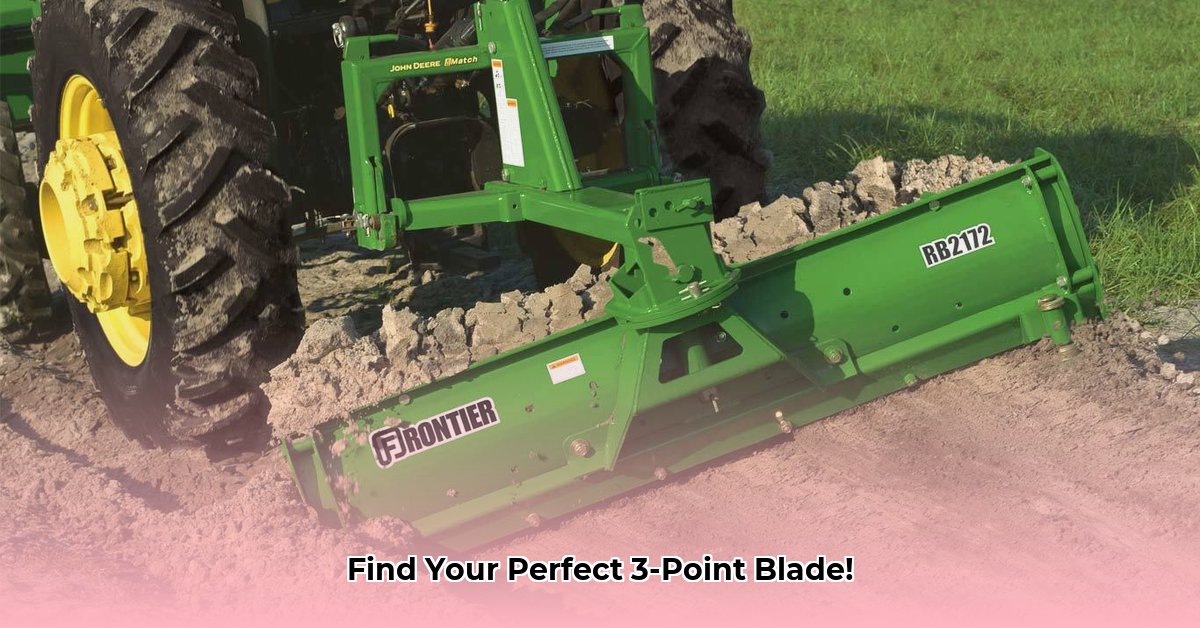
Finding the right 3-point blade can significantly impact your farm's efficiency. This guide helps you navigate the options, ensuring you choose the perfect tool for your needs. We'll cover blade types, key features, popular brands, and crucial maintenance tips. For additional tractor attachment options, check out this helpful resource on tractor hitches.
Understanding Your Needs: Application Defines the Blade
Before selecting a blade, determine its primary use. This dictates its ideal size, shape, and features. Different tasks call for different blade specializations.
Grading Blades: Versatile for leveling ground, preparing fields, or creating smooth surfaces. These are your all-around workhorses.
Ditching Blades: Designed for digging and cleaning ditches, these blades are narrower and deeper for efficient soil removal. Ideal for efficient drainage solutions.
Snowplowing Blades: Heavy-duty blades built to withstand the rigors of snow removal. Larger and sturdier than other types, often requiring hydraulic lifts for effective clearing. Essential for winter operations.
Beyond these, specialized blades exist for landscaping, forestry, or rock removal. Each has unique strengths and weaknesses. Do you need to handle heavy snow? (This will determine blade weight and horsepower requirements.)
Key Features: Decoding the Specs
Several key features differentiate 3-point blades:
Blade Angle Adjustment: Controls cutting depth. Hydraulic adjustment (smoother, faster changes) is superior to manual.
Tilt: Allows angling the blade to one side, crucial for precise grading and working near boundaries. Efficient perimeter work is invaluable for many farm operations.
Offset: Shifts the blade sideways from the tractor's center, important for working near obstacles without constant tractor maneuvering. Significant offset saves considerable time and effort.
Blade Material: High-strength steel (like Hardox 450) is the premium choice for durability and longevity. While more costly initially, it pays off in reduced replacement costs. It's a longer-term investment in efficient farming.
Actuation: Hydraulic actuation provides superior control and precision compared to manual (lever-operated) systems. Hydraulic systems provide significant advantages in terms of speed and control for larger projects.
Comparing Popular Brands: A Closer Look
This table compares popular 3-point blade brands. Prices and specifications are subject to change; check manufacturer websites for the most current information. Specific features vary among models.
| Brand | Model | Blade Width (inches) | Material | Horsepower Range | Offset Capability | Approximate Price (USD) | Hydraulic Tilt/Angle |
|---|---|---|---|---|---|---|---|
| Rhino Attachments | (Example Model) | 72, 84, 96 | Steel | 40-80 HP | Yes | $1500 - $3000 | Yes |
| Everything Attachments | (Example Model) | 60, 72, 84 | Steel | 30-60 HP | Yes | $1200 - $2500 | Yes |
| Land Pride | (Example Model) | 60, 72 | Steel | 35-75 HP | Yes | $1000 - $2000 | Yes |
Choosing Your 3-Point Blade: A Step-by-Step Guide
Identify Your Needs: What tasks will the blade perform most often? This prioritizes essential features.
Check Tractor Horsepower: Ensure your tractor's horsepower matches or slightly exceeds the blade's recommended range. Overloading is damaging to your machines.
Prioritize Features: Do you need hydraulic adjustment, offset, or specific materials? Balance features and budget.
Compare Specifications: Use the table as a starting point, but always verify details with manufacturers.
Budget Wisely: Higher-quality blades are more expensive upfront but offer superior durability and performance over time.
Seek Reviews: Online reviews provide valuable insights into user experiences and highlight potential issues.
Buy from Reputable Dealers: This ensures warranty support and easy access to parts and service.
Installation, Maintenance, and Troubleshooting
Installation: Always follow the manufacturer's instructions meticulously. Safety is paramount.
Maintenance: Regularly inspect for wear and tear, especially on the cutting edge. Sharpening or replacement is crucial for efficiency and safety. Keeping your equipment clean and well-maintained will help increase longevity.
Troubleshooting: Consult your owner's manual for common issues. Simple maintenance often resolves problems.
Choosing the right 3-point blade is crucial for efficient and safe operation. By following this guide and conducting thorough research, you will find the ideal blade to enhance your tractor's capabilities and ensure your farm's success. Remember, the most suitable blade is always tailored to your specific needs and budgetary constraints.